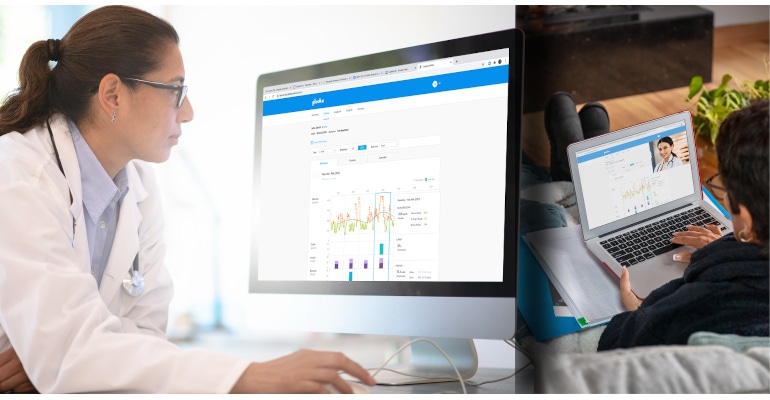Remote Patient Monitoring: A Platform for Innovations in Interdisciplinary Care Management
Remote patient monitoring provides opportunities for real-time, interdisciplinary care management of many chronic conditions, including diabetes.

The aftershocks of COVID-19 continue to reverberate throughout the U.S. healthcare system. For example, the pandemic has forever dispelled the quaint notion that “real” healthcare can only occur in hospitals and clinics. By drastically restricting in-person visits, COVID-19 has forced healthcare providers to find new ways to remotely engage, monitor, manage, and treat patients.
In the past two years, remote patient monitoring (RPM) platforms, devices, and tools have become commonplace components of healthcare delivery. Consider:
In a survey of 300 Americans, 80% had favorable views of RPM.
Insider Intelligence estimates that 30 million US patients, or 11.2% of the population, will use RPM tools by 2024.
In a large, international study, two-thirds of participants said they would adopt RPM in their regular diabetes care if it were somewhat more effective than their current care at improving health outcomes.
Another propellant accelerating widespread RPM adoption is the urgency of addressing what the American Medical Association (AMA) calls “an epidemic of chronic diseases.” According to the AMA, 86% of all the dollars the U.S. spends on healthcare—more than $3.4 trillion annually—is spent on chronic diseases such as heart disease, cancer, diabetes, and obesity that account for 70–75% of all deaths.
RPM solutions bring 24/7 care management support and real-time interventions into the home as integral parts of patients’ daily lives. To take full advantage of the RPM boom, device manufacturers need to adapt their offerings to fit seamlessly into new delivery models and protocols that emphasize a patient-centric, team-based approach to care management.
Based on our 10 years’ experience operating a connected-care RPM platform for diabetes and developing RPM digital companion tools, we want to share what we have learned to help others take advantage of burgeoning opportunities in this new world of virtual healthcare.
What is Remote Patient Monitoring (RPM) and Why Does It Matter?
RPM is primarily used for patients with chronic diseases to address problems relating to medications, infrequent surveillance, and behaviors. In many cases, the main purpose of more intensive monitoring is to continually observe, report, and analyze clinical indicators, which can signal the need for interventions.
For example, RPM digital solutions use prescribed sensors to capture patients’ physiological and behavioral data, which can then be transmitted to their physicians to complement in-person consultations or used to offer near-real-time feedback provided by artificial intelligence (AI) or a clinician. Other RPM tools engage and encourage patients to practice self-care and, most importantly, remain engaged with their treatment regimen – the World Health Organization estimates that 50% of people with chronic diseases do not take their medications as prescribed.
An Untapped Revenue Source for Health Systems and Clinics
Although payers and employers are deploying various RPM solutions to control costs, health systems have only recently begun to recognize the clinical and financial benefits of offering RPM services. In 2018, a KLAS Research survey of 25 healthcare organizations found that nearly 40% reported that RPM reduced hospital admissions, and 25% reported improved patient satisfaction and reduced readmissions.
Although many hospitals still view RPM services as a budgetary expense, recent changes in CMS reimbursement codes have created opportunities to use RPM to create new revenue streams. In 2018, CMS began issuing and accepting CPT codes to reimburse not only for the RPM activity of collecting patient data but also for providers’ time spent counseling patients to make therapy adjustments. CMS has since finalized payment for seven remote physiologic monitoring CPT codes and, in its proposed 2022 Physician Fee Schedule, added five CPT codes for remote therapeutic monitoring (RTM) services, including therapy adherence and response.
Designing Devices for Healthcare’s Complex Ecosystem
Not too long ago, device manufacturers’ primary focus was designing products for use in familiar clinical settings with well-established protocols. In the real world, however, each setting is unique, and devices must be designed to work seamlessly as integral parts of multi-dimensional and interdependent RPM solutions. Developmental considerations should include how products (and the data they generate) are used by physicians, clinicians, health systems, EHRs, payers, communications systems, and, most importantly, the patients themselves.
In developing devices for this complex ecosystem, companies must ask questions such as:
What information from the device is most important, and what can we do to make this more timely, valuable, accessible, and actionable for patients and clinicians?
Can the device be easily integrated with apps and other devices (e.g., fitness trackers or blood glucose monitors) the patient is already using?
How can we make the device easier for patients to use and more effective in getting them to adhere to treatment plans or modify behaviors that would improve outcomes?
What are payers’ specific data requirements?
RPM Platforms for Interdisciplinary ‘Circles of Care’
Optimizing care for patients in their homes is a team effort that requires interdisciplinary communications, collaboration, and the integration of data from multiple sources, including EHRs and patients’ health and fitness devices. Since RPM platforms are typically used to facilitate or perform many of these functions, device manufacturers need to be judicious about choosing the right platform to deploy their RPM solutions. Factors to consider in making this decision include:
The ease with which clinics and care teams can access, share, and gain insights from devices, patient-generated data, and other sources, including the patient’s EHR.
The richness and size of the platform’s real-world datasets.
The platform provider’s depth of experience in launching and supporting RPM platforms and devices worldwide.
The ability to integrate with multiple devices and deliver solutions based on the patient’s insurance and/or personal needs and preferences.
The scalability to expand into adjacent health conditions as needed.
Ideally, an RPM platform will help connect devices with patients, providers, and data to create a “circle of care” to optimize health outcomes. As RPM-driven data sets continue to grow, this information will eventually be used to risk stratify patient populations to determine who needs more (or less) frequent or intensive interactions.
RPM in Action: Glycemic Control in Diabetes Patients
Emerging evidence indicates that RPM solutions are especially effective in treating complex disease states that 1) involve patient self-management, and 2) can benefit from constant monitoring, frequent reviews of data, and therapeutic adjustments. A prime example of how RPM devices, platforms, and tools can achieve better health outcomes is their increasing use in managing glycemic control in patients with diabetes.
In the landmark 1993 Diabetes Control and Complications Trial study, results showed that intensive therapy of insulin injections—guided by frequent blood glucose monitoring to maintain blood glucose concentrations close to the normal range—could effectively delay the onset and slow the progression of diabetic retinopathy, nephropathy, and neuropathy in Type 1 (insulin-dependent) patients. Five years later, a second prospective study of patients with type 2 diabetes in the UK also demonstrated the benefits of intensive blood-glucose control.
For more than 30 years, diabetes patients have been using devices to monitor their blood glucose levels in the home. Today, they have a wide array of syringes, pumps, and pens for insulin delivery, including closed-loop delivery systems that use computer algorithms to determine dosing levels. Yet despite all these advances, the glucose ranges for far too many patients are too often out of control; for example, fewer than 50% of Type 2 diabetes patients on long-acting insulin are able to achieve their target glycemic outcomes.
As with most chronic diseases, the causes of pervasive problems with diabetes—engaging with medication regimens; infrequent and/or inconsistent monitoring of key clinical indicators; insufficient data and alerts to trigger necessary interventions; patient behaviors that increase the likelihood of disease progression—are all too familiar. Advanced RPM platforms can bring together the devices, analytical tools, and personalized interventions and support to prevent and/or mitigate these problems.
Recent clinical and real-world studies conducted by our teams of investigators provide strong evidence that RPM solutions using continuous glucose monitoring (CGM) and blood glucose monitoring (BGM) devices, companion analytic tools, and telehealth coaching can help patients better control their glycemic levels.
In one real-world study, people with diabetes (PWD) who were enrolled in RPM pilot programs across U.S. healthcare systems were encouraged to use a diabetes management mobile app to sync blood glucose, medication, and lifestyle information. RPM care teams monitored these data remotely and provided coaching as needed. When comparing results to pre-RPM self-monitored blood glucose data (SMBG) data collected at enrollment, the researchers observed immediate and sustained improvements across multiple glycemic outcomes following various durations of RPM of up to 12 months.
Since self-adjusting insulin is challenging for people with type 2 diabetes (PWT2D), a randomized clinical trial compared an app-based self-titration tool with an enhanced paper titration tool with diabetes educator support (control group). The app-based tool analyzed a PWT2D’s fasting blood glucose levels and recommends insulin dose adjustments based on a physician’s pre-configured treatment plan and/or published clinical guidelines. Although PWT2Ds in both groups showed higher insulin dose and significantly improved glycemic control after 16 weeks, the group with the self-titration app demonstrated a greater proportion of SMBG readings between the target range of 70-180 mg/dL and fewer high SMBG readings (>250 mg/dL).
Final Thoughts
Because of the seismic changes precipitated by COVID-19 in combination with an uncontrolled epidemic of chronic diseases, patients’ homes are fast-becoming the epicenter of innovative healthcare solutions. Robust, data-rich RPM platforms can provide a platform for testing new approaches for real-time, interdisciplinary care management.
As we’ve seen, opportunities for device manufacturers to leverage these platforms are boundless. But while new technologies no doubt will exponentially improve the collection, availability, and value of data, human connections, interactions, and behaviors are still fundamental determinants of health outcomes. Vital connections between patients and their trusted physicians and caregivers must be strengthened, not disintermediated.
Device manufacturers whose RPM solutions facilitate these connections, engage the entire healthcare ecosystem, and humanize the digital experience will be well-positioned for success.
About the Author(s)
You May Also Like





.png?width=300&auto=webp&quality=80&disable=upscale)
